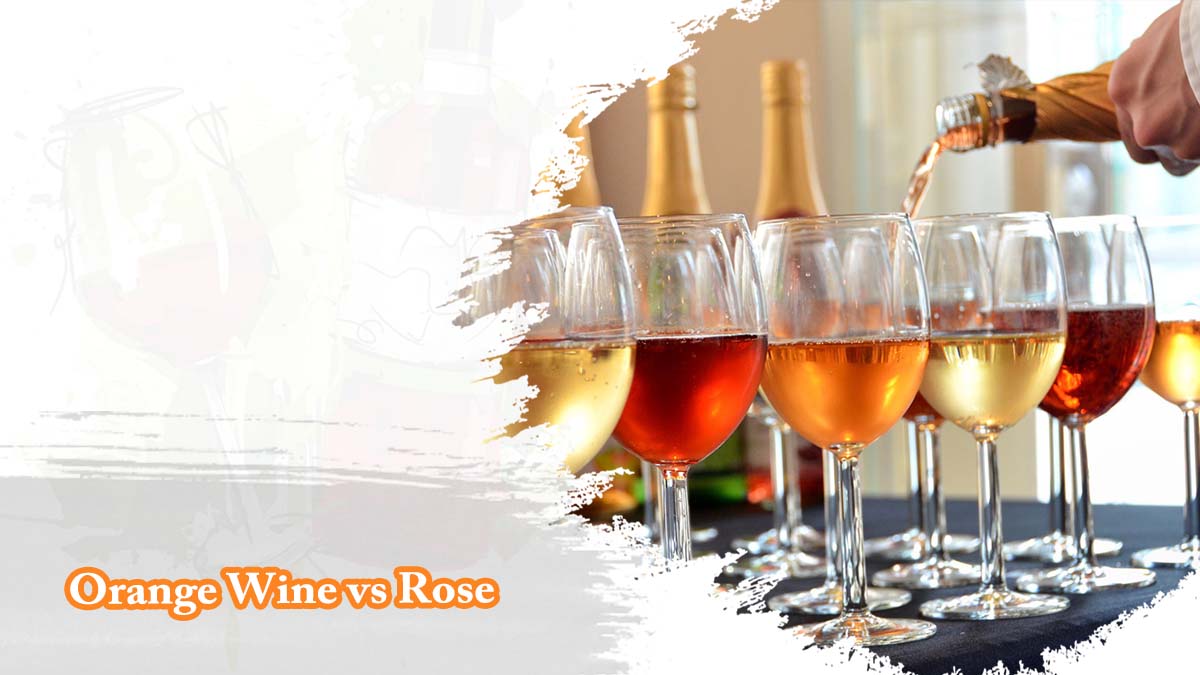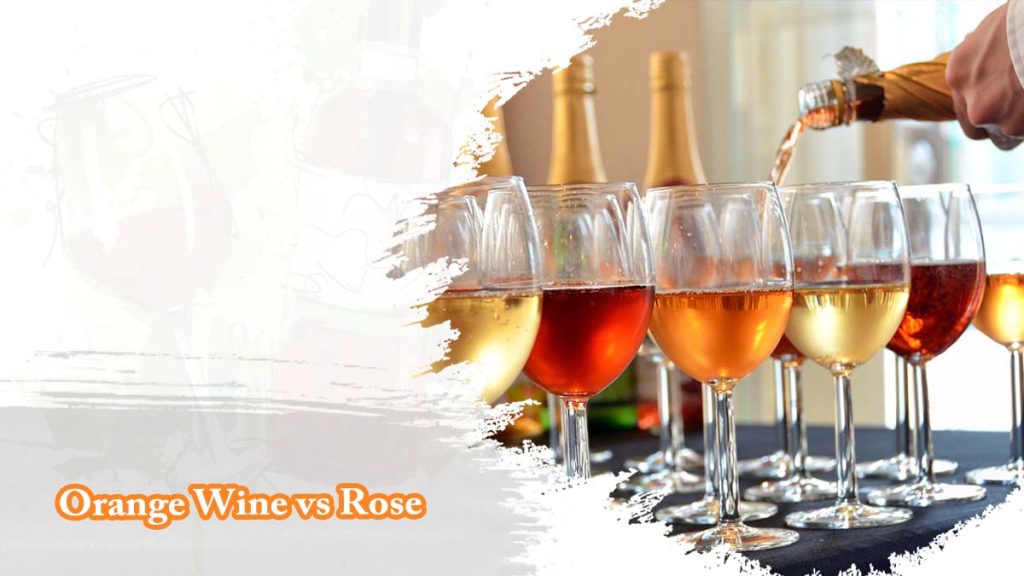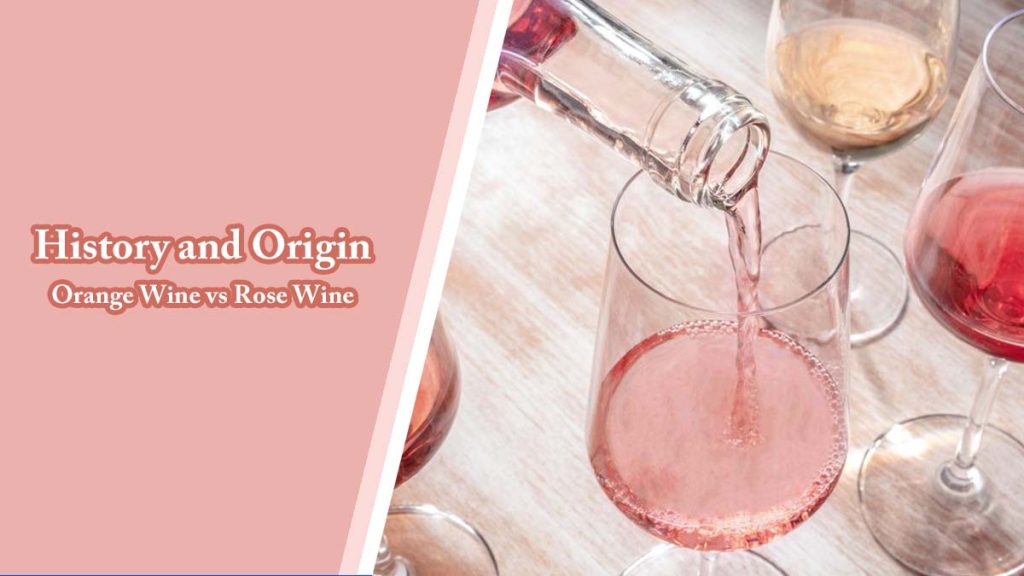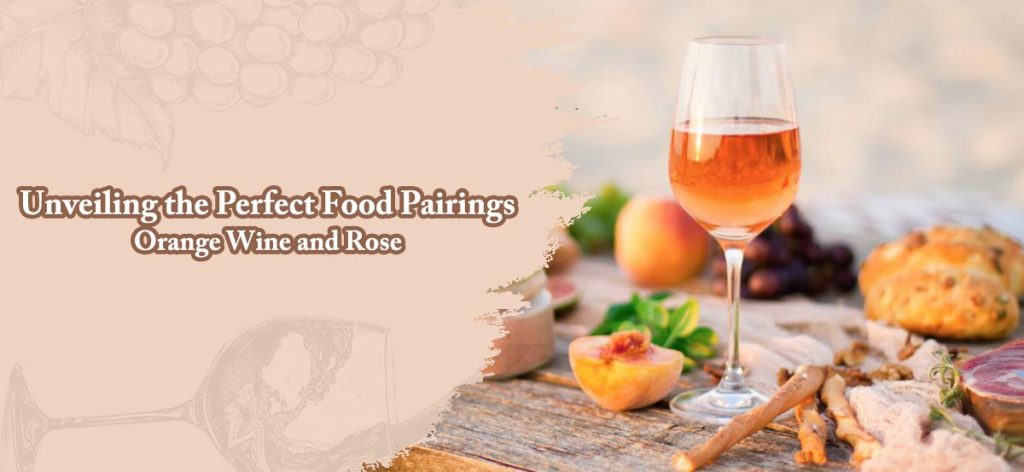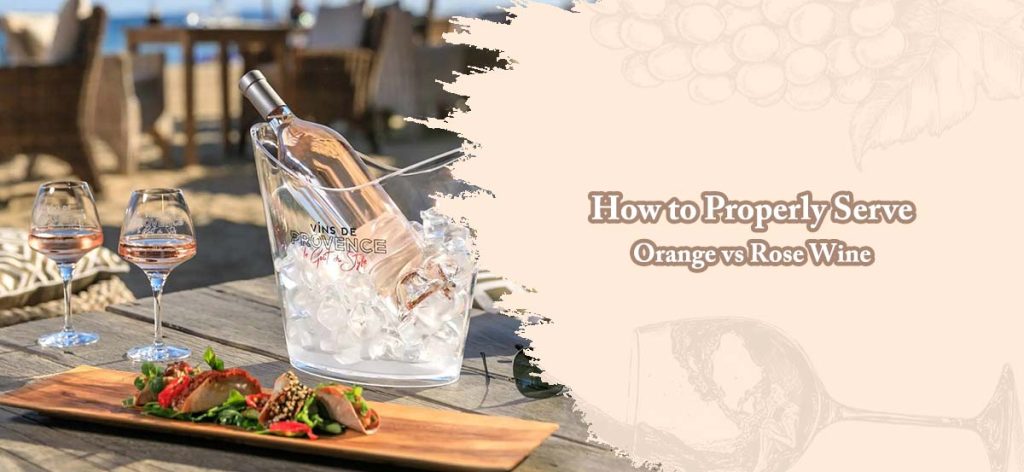Orange Wine vs Rose
Wine is a rich, complex beverage that has long been enjoyed by people of all cultures for its diverse flavors and aromas. While many individuals are familiar with the likes of red and white wines, there are other options to explore. Two of the most popular styles of wines you may have heard of include Orange Wine vs Rose. These wines have been around for centuries but are only recently gaining recognition and popularity.
These varietals have become extremely trendy in recent years due to their unique flavor profiles that provide a sensory experience unlike any other. Whether you’re looking for a dry white or sweet blush, there are opportunities with both orange and rose flavors that can be enjoyed alone or accompany savory dishes perfectly.
But, what sets them apart, which pairs better with certain food, or even where to find it? Well, wonder no more – in this blog post, we’ll explore these two unique wines to help you decide which one is right for you. From flavor profiles to production processes and pairing recommendations, by the end of this post, you’ll know everything there is to know about orange wine and rose! So if you’d like an educational and enjoyable tour through two delicious wines, let’s start exploring together!
Overview of Orange Wine and Rose
A Rosé wine, also known as Rosado, is a type of wine that is produced using a combination of red and white grapes. Unlike red wine, Rosé wine does not undergo an extended maceration process that brings out the tannin from the grape skins. Instead, this pink wine is produced by removing the grape skins from the juice after a short period of contact, typically just a few hours to a couple of days. This process gives the wine a distinct, light-bodied, and fruity flavor that is perfect for hot summer days.
On the other hand, Orange wine is a style of wine that has gained popularity in recent years. It is produced using white wine grapes, but the fermentation process is carried out using whole grape clusters, including skins, seeds, and stems. This extended contact with the grape skins gives Orange wines a unique copper color and tannic structure that is similar to red wines. The result is a wine with a bold, complex flavor profile that pairs well with hearty, flavourful dishes.
In terms of flavor profiles, Rosé wines tend to be light, delicate, and fruity. You can expect a refreshing dash of acidity and crispness with notes of red fruit such as strawberry, raspberry, and cherry. They are easy to drink and pair well with light dishes, such as salads or seafood. In contrast, Orange wines tend to have a more complex and bold character. They often have notes of dried fruits, florals, and a touch of bitterness that comes from the extended skin contact. These wines pair well with, robust dishes such as pork, lamb, or venison.
Aside from the flavor profile, another factor that separates these two types of wine is the way they are produced. Rosé wines are typically lighter and best consumed cold, while Orange wines are typically heavier, and more complex and are best consumed at room temperature to allow for the wine’s flavors and aromas to fully develop.
If you are looking to expand your wine palate and try something beyond the traditional red and white wines, you should give Rose and Orange wines a try. Both of these types of wines are remarkable and offer a unique sensory experience that is hard to match. They have distinctive flavor profiles, pair well with different types of food, and come in a range of styles to suit every palate.
History and Origin of Orange Wine vs Rose Wine
Wine has been a part of society for centuries, and with advancements in technology, the varieties of wine available have increased. Among the many varieties of wine, rose and orange wines are gaining popularity lately. These wines are unique in their way, both in terms of taste and color. Now, we shall look at the history and origin of orange wine vs rose wine.
Orange wine is made by allowing white grapes to ferment along with their skins, like red wine. It originates from Georgia, where it has been made for over 4,500 years. This technique became popular in neighboring countries such as Italy, Slovenia, and Croatia. These countries made this wine using different grapes and processes, creating different flavors and aromas. Orange wines are unique because they have a longer fermentation period, giving them a complex taste and texture.
Rose wine also dates back to ancient civilization, where the Greeks made it by leaving the wine to settle with grape skins, imparting a subtle pink color. However, the French get the credit for making rose wine famous. They created the style we know today, which involves crushing red grapes and leaving the skins in contact with the juice for a short time before fermentation. This gives rose wine its distinct pink color and fruity taste.
Orange wines and rose wines are becoming more popular among wine lovers, but they are not without their detractors. Orange wines can have a funkiness to their flavors, while the acidity in rose wines can be too much for some people. However, the popularity of these wines shows that there is a market for more experimental and complex wines.
Wine has been a part of human history for a long time, and the varieties of wine available today are the result of centuries of experimentation and innovation. Orange wine and rose wine are two unique styles that are gaining popularity.
Exploring the Differences Between Orange Wine and Rosé
These two types of wine share a similar pinkish hue, but they have distinct differences in appearance, aroma, sweetness, body, tannin levels, acidity, and alcohol content. In this comprehensive guide, we will explore the unique characteristics of orange wine versus rosé and help you understand the differences better.
Appearance: Orange wine gets its name from its color, which ranges from pale orange to deep amber, depending on the grape variety, production process, and aging. Orange wine is made from white grapes that are allowed to macerate with their skins and seeds for a few days to several months, resulting in a wine with a slightly oxidized hue. In contrast, rosé wine comes from black grapes with red skins and is produced by allowing the skins to soak in the juice for a limited period, resulting in a pinkish color that ranges from pale salmon to deep ruby.
Aroma: The aroma of orange wine is complex and can range from nutty to floral, with notes of apricot, honey, and spice. The aroma of rosé wine is also diverse but tends to be light, fruity, and floral, with hints of red berries, citrus, and tropical fruit.
Sweetness: Orange wine is often described as dry or off-dry, meaning it has little sweetness. However, some orange wines can have a subtle sweetness due to residual sugar in the wine. Rosé wine varies in sweetness, from bone-dry to off-dry to semi-sweet, depending on the grape variety and production process.
Body: Orange wine has a more robust and structured body than rosé due to its skin contact during maceration, resulting in a wine with more tannins and astringency. Rosé wine has a lighter body and is much less tannic than orange wine.
Tannin Levels: Tannins are compounds present in grapes, skins, and seeds that give the wine its structure, bitterness, and dryness. Orange wine has higher tannin levels than rosé wine, mainly due to skin contact during fermentation. Rosé wine has low to medium tannin levels, depending on the grape variety and production process.
Acidity: Acidity refers to the tartness and sharpness of wine and is an essential factor in how wine tastes. Orange wine has higher acidity levels than most white wines and is often compared to red wine in terms of its acidity levels. Rosé wine has moderate to high acidity, giving it a crisp and refreshing taste.
Alcohol Content: The alcohol content of wine is measured in ABV (alcohol by volume) and varies depending on the grape variety, sugar levels, and fermentation process. Orange wine has a higher alcohol content than rosé wine, ranging from 12% to 15% ABV, while rosé wine has an alcohol content of approximately 11% to 14% ABV.
Summary:
The main differences between the characteristics of orange wine and rose wine are their appearance, aroma, sweetness, body, tannin levels, acidity, and alcohol content.
Orange wine gets its name from its color which ranges from pale orange to deep amber. It has a more robust and structured body than rosé due to increased skin contact during maceration resulting in a wine with more tannins and astringency. The aroma of orange wines is complex and can range from nutty to floral notes of apricot, honey, and spice.
Rosé wines have lighter bodies that range in sweetness from bone-dry to off-dry to semi-sweet depending on the grape variety and production process. They usually have a light fruity or floral aroma with hints of red berries, citrus, or tropical fruit flavors.
They typically have moderate to high acidity giving them a crisp refreshing taste while also having an alcohol content ranging from 11%–14%. In contrast, orange wine has a higher alcohol content ranging from 12%–15%, as well as higher acidity levels and tannin levels.
Overall, both wines are beautiful in their unique way, with rosé being a great summer pick-me-up and orange wine offering an interesting flavor profile to explore.
Unveiling the Perfect Food Pairings for Orange Wine and Rose
Wine lovers know that the right food pairing can make all the difference in their enjoyment of a particular wine. With so many varieties of wine available, it can be a daunting task to find the perfect food pairing. As a wine enthusiast, have you ever wondered about the food pairings for Orange Wine and Rose, and how they differ from each other? Now, we’ll discuss the ideal food pairings for Orange Wine and Rose and showcase the differences between them.
Orange Wines are a kind of white wine that has been made by leaving the grape skins on the juice, resulting in a distinct orange color. This process also contributes to its unique flavor profile, characterized by a nutty, oxidized, and tannic taste. The ideal food pairings for Orange Wines are meats cooked with earthy spices such as cinnamon, coriander, or cumin. The savory flavors of roasted chicken, duck, or braised beef, are ideal matches for the distinct flavors of Orange Wine. Its cheese pairing includes firm cheeses like Parmesan and Gouda, with their nutty and salty notes complementing the wine’s flavors.
On the other hand, Rose wines are typically made from red grape varietals, with the grape skins separated from the juice after minimal contact. This results in a beautiful pink hue, and it is known for its refreshing and fruity nature. The perfect food pairings for Rose include light dishes with mild spices, such as fish, seafood, and fresh salads. The overall goal is to maintain the wine’s refreshing nature while accentuating its fruit flavors. To complement its fruity nature, the best cheese pairing would be a soft cheese like Brie or Camembert.
Orange Wines and Roses may have their unique taste profiles, but there are cross-over dishes that work well with either wine. Spicy foods that have a hint of sweetness or dishes that include garlic and mushrooms are good examples. These dishes go great with both wines, thanks to their ability to balance the acid and fruity notes, which creates the perfect synergy between the dish and the wine.
It is crucial to note that when pairing food and wine, there are no strict rules. Experiment and be open to trying new pairings, and who knows! You might find a new pairing that complements your favorite wine perfectly. Remember, the goal is to enhance your overall dining experience by enjoying the flavors of both your food and wine fully.
Examining the Different Styles of Production for Each Type of Wine
The great variety of wine options available in the market today is due to the different methods of production used by different winemakers. Here, we’ll take a closer look at the differences in production techniques for orange wine and rose two increasingly popular wine varieties.
Orange wine, also known as amber wine, has been around for centuries. This type of wine gets its name from its deep orange color, which is achieved by leaving the skins of the grapes on during fermentation. This technique is quite different from traditional white wine production, where the grape skins are removed before fermentation. The longer fermentation time and exposure to the skins of the grapes give orange wine a tannic taste, making it a more full-bodied wine. Orange wine is often made with organically grown grapes and has a longer shelf life than other white wines.
In contrast, rose wine is made using a process called maceration, where grape skins are left in contact with the fermenting juice for a very short time, typically just a few hours. This is just enough time for the wine to take on a delicate pink color. Compared to white wine, rose has a slightly higher alcohol content and a more pronounced fruit flavor.
Orange wine is often made with wild yeasts, while rose winemakers generally use selected yeasts. As a result, orange wine tends to have a more complex flavor profile, whereas rose wines often have a more consistent taste. Winemakers who produce orange wines celebrate the natural yeasts and bacteria that are present in the fermentation process, whereas rose winemakers aim to maintain control over the process to achieve consistent flavor.
Although orange wine is produced differently from rose, the two share some similarities. Both types of wine are often produced using natural or organic farming practices, and both have enjoyed increasing popularity in recent years. While orange wine tends to be bolder and more complex, rose is generally lighter and more approachable.
Read more about Moscato vs Rose Wine.
Breaking Down The Cost Difference Between Orange Wine and Rose
When it comes to choosing a bottle of wine, there is an endless array of options to choose from. Two popular options that have been gaining attention over the years are orange wine and rose. However, as their popularity grows, so does the confusion over their prices. What makes one more expensive than the other?
1. Production process
One of the biggest differences between orange wine and rose is the production process. Orange wine is made by leaving white grapes in contact with the skin for an extended period, resulting in a deeper color and a more complex flavor profile. In contrast, rose is made by leaving red grapes in contact with the skin for a shorter time, resulting in a lighter color and more straightforward flavor profile. The longer and more intricate production process of orange wines is reflected in their higher price point.
2. Grape quality
The quality of the grapes used in the winemaking process is another factor that can impact the cost difference between orange wine and rose. Orange wines are made using the highest quality white grape varieties, and they often come from vineyards that specialize in natural and organic farming practices, which can increase their production costs. In contrast, roses can be made with a variety of red grapes, which can vary greatly in quality and price, making them generally less expensive.
3. Fermentation and aging
Fermentation and aging processes can also impact the cost of wine. Orange wine is typically fermented and aged in clay amphorae or oak barrels, which can be a significant investment for winemakers. The longer the wine spends in these vessels, the higher the production cost, which can lead to a higher price point for the finished product. On the other hand, roses are often fermented in stainless steel tanks, which are more affordable and efficient, resulting in a lower price point.
4. Rarity and demand
The rarity and demand of a wine can also factor into its price. Orange wine is still a relatively niche product, with a limited supply, particularly from top producers. As such, it is often priced higher, as the demand for the unique flavor profile and winemaking techniques increases. In contrast, roses are widely produced and tend to be more ubiquitous on wine shelves, resulting in a lower price point.
5. Brand and marketing
Lastly, the branding and marketing of a wine can also impact its cost. Branding can convey a sense of exclusivity, quality, and luxury. As such, some orange wine producers have capitalized on this by offering artisanal, small-batch production, unique label designs, and high-end marketing tactics, which can add to their overall cost. Roses, as a more approachable and versatile wine, often have simpler, more straightforward marketing efforts and may not carry the same levels of exclusivity, leading to a lower price point.
The cost difference between orange wine and rose can be explained by several factors, including the production process, grape quality, fermentation and aging, rarity and demand, and branding and marketing. While orange wines tend to be more expensive overall, it is important to consider the production values and quality of the product before making a purchase. Ultimately, the final decision should always be based on personal preference and taste, rather than cost alone.
How to Properly Serve Orange and Rose Wine
With the boom of wine culture and the popularity of social drinking, it’s essential to know how to serve each type of wine properly. Knowing the right temperature, glassware, and serving etiquette can take your wine-serving game to the next level. We will focus on two types of wine: orange and rose wine. We’ll discuss how to serve them when to drink them, and a few other essential tips to impress your guests.
Orange wine is not exactly orange, nor is it related to oranges. It is a white wine that gets its orange color from leaving the skins on the grapes during fermentation. This process creates a deeper flavor profile than most white wines, and it pairs well with robust meals like curry or BBQ. The ideal temperature to serve orange wine is around 60-65°F or 15-18°C. The best glassware to serve orange wine is a large, rounder bowl-shaped glass, similar to those used to serve red wines. These types of glasses allow the wine to breathe, bringing out its unique flavor and aroma.
Rose wine, on the other hand, is the perfect summer wine. It’s light, and refreshing, and pairs great with salads, seafood, or light pasta dishes. The ideal temperature to serve rose wine is between 45-60°F and 7-15°C. The best glassware to serve rose wine is a taller, thinner glass, such as a champagne flute or a tulip glass. These types of glasses help capture the wine’s aroma while keeping it cold for longer.
When it comes to serving orange or rose wines, there are a few etiquettes to remember.
- Firstly, always hold the wineglass by the stem, not the bowl. This helps prevent the wine from warming up from the heat of your hand, as well as preventing fingerprints on the glass.
- Secondly, always serve wine from the right-hand side of the guest, in a clockwise direction. This practice helps make sure that guests can pour their wine without their glasses hitting each other.
- Lastly, always fill the glass only a third full, allowing enough room for the wine to breathe while also leaving enough space for the guest to swirl and smell the wine aromas.
In the end, serving orange and rose wine does not have to be complicated. With these tips, you can serve each type of wine with confidence and flair. Choose the ideal glassware, serve it at the right temperature, and remember to pour it from the right-hand side.
FAQs
What is the difference between orange wine and rose wine?
The main difference between orange wine and rose wine is the production method. Orange wines are made from white grapes that have been fermented with the skin, giving them an amber-orange hue. Rose wines are made with a combination of red and white grapes but do not ferment on the skin so they take on a pink color.
Orange wines also tend to have more tannins than rose wines making them drier and more complex in flavor. Additionally, orange wines often use wild yeast as opposed to cultured yeast which can give it earthy flavors that aren’t present in roses.
How does orange wine compare to rose in terms of taste?
Orange wine is typically known for its complex and tannic flavor profile, which can be quite different from that of rose wines. Generally speaking, orange wines tend to be more tart and savory than rose wines, with notes of dried fruit, nuts, tea leaves, and herbs. They generally have a fuller body and mouthfeel than their pink counterparts. Orange wines also often have higher levels of acidity, which gives them an almost refreshing quality. In contrast, rose wines tend to have a more subtle fruitiness with floral aromas and flavors that are slightly sweet. Rose wines tend to be lighter-bodied and less acidic than orange wines, making them better suited for sipping on hot days or pairing with lighter dishes.
Is orange wine more expensive than a rose?
Orange wines can generally be more expensive than rose wines since the production process is often longer and more labor-intensive. For example, producing orange wines requires that grapes be fermented on their skins for an extended period to achieve the desired amber-orange hue. This process can add additional costs and complexities to the production of orange wine, driving up its price tag.
On the other hand, producing rose wines does not require a long fermentation time with the skins, making it less costly. Additionally, rose wines are typically made with only red and white grapes which tend to be less expensive than some of the unique grape varieties used in orange wine production. Ultimately, this can lead to a wide range of price points depending on the type and quality of each variety.
Can I pair both wines together for a meal?
Yes, you can definitely pair both orange wine and rose together for a meal. Orange wines typically have a complex flavor profile with notes of dried fruit, nuts, tea leaves, and herbs that often pairs well with heavier dishes such as braised meats, root vegetables, and aged cheeses.
On the other hand, rose wines tend to be lighter in body and slightly sweet which is why they are often paired with lighter items such as grilled white fish, salads, or creamy pasta.
Does one type of wine get you drunker faster than the other?
It depends on the type of wine and how much you drink. Generally speaking, wines with higher alcohol content such as fortified wines or ports will get you drunker faster than lower-alcohol wines like rose or orange wine. Sweet wines may contain more calories, but they usually have a lower alcohol content than dry wines so it would take longer to reach the same level of intoxication.
Additionally, your body’s tolerance for alcohol also plays a role in how quickly you get drunk from drinking any type of alcoholic beverage. To avoid becoming overly intoxicated, always remember to drink responsibly and in moderation.
Conclusion
After reviewing all the facts, it’s clear that both rose and orange wines offer a great deal for wine drinkers. Rose offers fruit-forward, lighter-bodied aromas with subtle tannins, while orange wine has a fuller-bodied feel and offers a unique complexity. As we compare and contrast these two compelling selections of wines, it’s easy to see why so many wine lovers make room in their collections for both rose and orange wines. We hope this blog has helped provide insight into the differences between each type of wine, allowing you to make informed decisions when deciding what to buy next.
It is our sincere thanks to all our readers who have joined us on this journey through the stylish flavors of rose and orange wines! We look forward to future conversations on the topic of winemaking and encourage everyone to keep experimenting with different types of varieties within the category they love most.
Visit our Website for more interesting things.

I am Thomas Delange, CEO of McMahon’s Public House bar. I have a passion for restaurants and cooking & wines, and I love to spend my free time experimenting in the kitchen. I’ve worked hard to make McMahon’s one of the most successful bars in the city. When I’m not working, I enjoy spending time with my friends and family.

